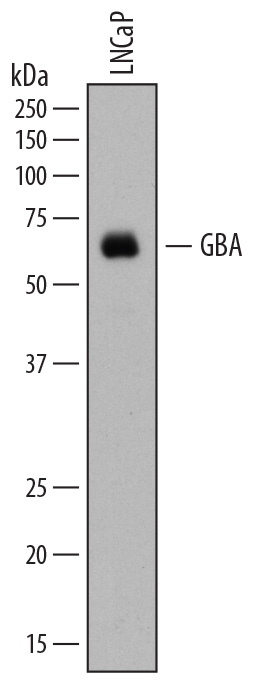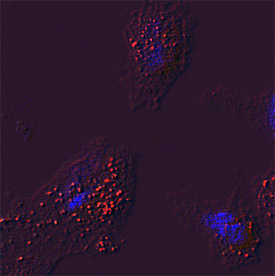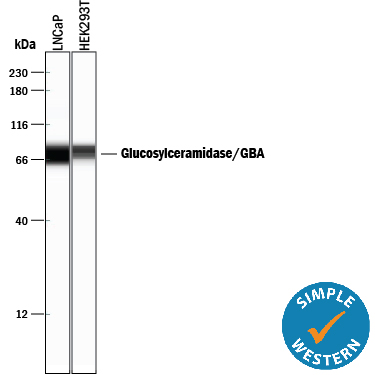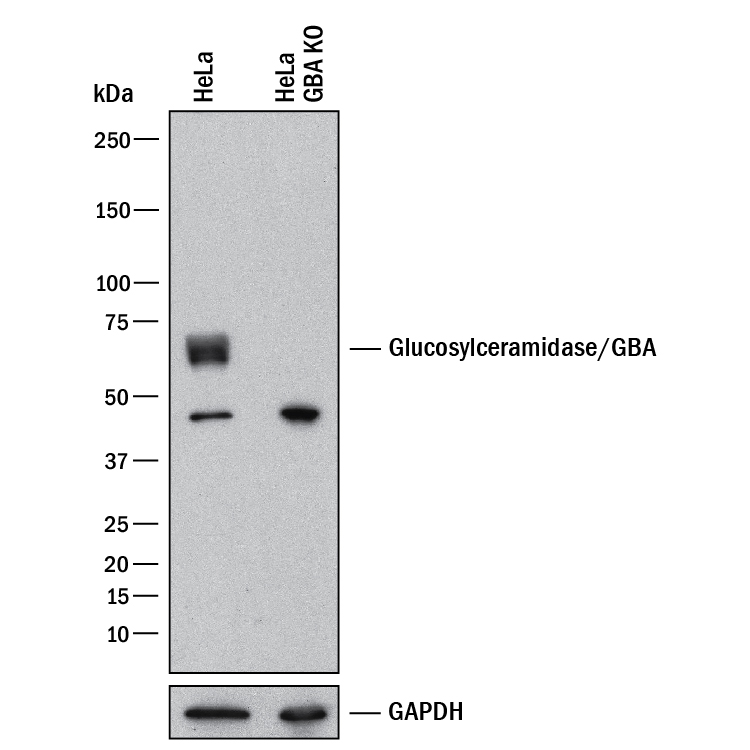Human Glucosylceramidase/GBA Antibody Summary
Met1-Gln536
Accession # P04062
Applications
Please Note: Optimal dilutions should be determined by each laboratory for each application. General Protocols are available in the Technical Information section on our website.
Scientific Data
 View Larger
View Larger
Detection of Human Glucosylceramidase/GBA by Western Blot. Western blot shows lysates of LNCaP human prostate cancer cell line. PVDF membrane was probed with 1 µg/mL of Mouse Anti-Human Glucosylceramidase/GBA Monoclonal Antibody (Catalog # MAB7410) followed by HRP-conjugated Anti-Mouse IgG Secondary Antibody (Catalog # HAF007). A specific band was detected for Glucosylceramidase/GBA at approximately 60 kDa (as indicated). This experiment was conducted under reducing conditions and using Immunoblot Buffer Group 1.
 View Larger
View Larger
Glucosylceramidase/GBA in HeLa Human Cell Line. Glucosylceramidase/GBA was detected in immersion fixed HeLa human cervical epithelial carcinoma cell line using Mouse Anti-Human Glucosylceramidase/GBA Monoclonal Antibody (Catalog # MAB7410) at 15 µg/mL for 3 hours at room temperature. Cells were stained using the Northern-Lights™ 557-conjugated Anti-Mouse IgG Secondary Antibody (red; Catalog # NL007) and counterstained with DAPI (blue). Specific staining was localized to lysosomes. View our protocol for Fluorescent ICC Staining of Cells on Coverslips.
 View Larger
View Larger
Detection of Human Glucosylceramidase/GBA by Simple WesternTM. Simple Western lane view shows lysates of LNCaP human prostate cancer cell line and HEK293T human embryonic kidney cell line, loaded at 0.2 mg/mL. A specific band was detected for Glucosylceramidase/GBA at approximately 77 kDa (as indicated) using 10 µg/mL of Mouse Anti-Human Glucosylceramidase/GBA Monoclonal Antibody (Catalog # MAB7410). This experiment was conducted under reducing conditions and using the 12-230 kDa separation system.
 View Larger
View Larger
Western Blot Shows Human Glucosylceramidase/GBA Specificity by Using Knockout Cell Line. Western blot shows lysates of HeLa human cervical epithelial carcinoma cell line and human GBA knockout HeLa human cervical epithelial carcinoma cell line. PVDF membrane was probed with 1 µg/mL of Mouse Anti-Human Glucosylceramidase/GBA Monoclonal Antibody (Catalog # MAB7410) followed by HRP-conjugated Anti-Mouse IgG Secondary Antibody (HAF007). A specific band was detected for Glucosylceramidase/GBA at approximately 65 kDa (as indicated) in the parental HeLa human cervical epithelial carcinoma cell line, but is not detectable in knockout HeLa human cervical epithelial carcinoma cell line. GAPDH (MAB5718) is shown as a loading control. This experiment was conducted under reducing conditions and using Western Blot Buffer Group 1.
Reconstitution Calculator
Preparation and Storage
- 12 months from date of receipt, -20 to -70 °C as supplied.
- 1 month, 2 to 8 °C under sterile conditions after reconstitution.
- 6 months, -20 to -70 °C under sterile conditions after reconstitution.
Background: Glucosylceramidase/GBA
Glucosylceramidase is a lysosomal enzyme that cleaves the beta-glucosidic linkage of glucosylceramide (1, 2), an intermediate in glycolipid metabolism. The mature enzyme has 497 amino acids with a molecular weight of 62 kDa (3). Glycosylation occurs at four of five N-glycosylation sites and is essential for the trafficking and activity of the enzyme (4). The enzyme is activated in lysosomes by saposin C, although the mechanism of activation is not well understood (5). Defects in Glucosylceramidase are the cause of Gaucher disease, also known as glucocerebrosidase deficiency (6). Gaucher disease is the most prevalent lysosomal storage disease, characterized by accumulation of glucosylceramide in the reticulo-endothelial system. Symptoms of Gaucher disease may include enlarged spleen and liver, liver malfunction, skeletal disorders and bone lesions, severe neurologic complications, swelling of lymph nodes, anemia, low blood platelets and yellow fatty deposits on the white of the eye (7). Currently, enzyme replacement therapy is used to treat patients with the disease (8, 9).
- Sorge, J. et al. (1985) Proc. Natl. Acad. Sci. USA 82:7289.
- Ginns, E. I. et al. (1984) Biochem. Biophyl. Res. Commun. 123:574.
- Horowitz, M. et al. (1989) Genomics 4:87.
- Grace, M.E. et al. (1994) J. Biol. Chem. 269:2283.
- Bruhn, h. (2005) Biochem. J. 389:249.
- Liou, B. et al. (2006) J. Biol. Chem. 281:4242.
- Grabowski, G.A. (2008). Lancet 372: 1263–1271.
- Zheng, W. et al. (2007) Proc. Natl. Acad. Sci. USA 104:13192.
- Beutler, E. and Gelbart, T. (1996) Hum. Mutat. 8:207.
Product Datasheets
Citation for Human Glucosylceramidase/GBA Antibody
R&D Systems personnel manually curate a database that contains references using R&D Systems products. The data collected includes not only links to publications in PubMed, but also provides information about sample types, species, and experimental conditions.
1 Citation: Showing 1 - 1
-
Patients with sporadic FTLD exhibit similar increases in lysosomal proteins and storage material as patients with FTD due to GRN mutations
Authors: SE Davis, AK Cook, JA Hall, Y Voskobiyny, NV Carullo, NR Boyle, AR Hakim, KM Anderson, KP Hobdy, DA Pugh, CF Murchison, LJ McMeekin, M Simmons, KA Margolies, RM Cowell, AL Nana, S Spina, LT Grinberg, BL Miller, WW Seeley, AE Arrant
Acta neuropathologica communications, 2023-04-28;11(1):70.
Species: Human
Sample Types: Whole Tissue
Applications: IHC
FAQs
No product specific FAQs exist for this product, however you may
View all Antibody FAQsReviews for Human Glucosylceramidase/GBA Antibody
There are currently no reviews for this product. Be the first to review Human Glucosylceramidase/GBA Antibody and earn rewards!
Have you used Human Glucosylceramidase/GBA Antibody?
Submit a review and receive an Amazon gift card.
$25/€18/£15/$25CAN/¥75 Yuan/¥1250 Yen for a review with an image
$10/€7/£6/$10 CAD/¥70 Yuan/¥1110 Yen for a review without an image

